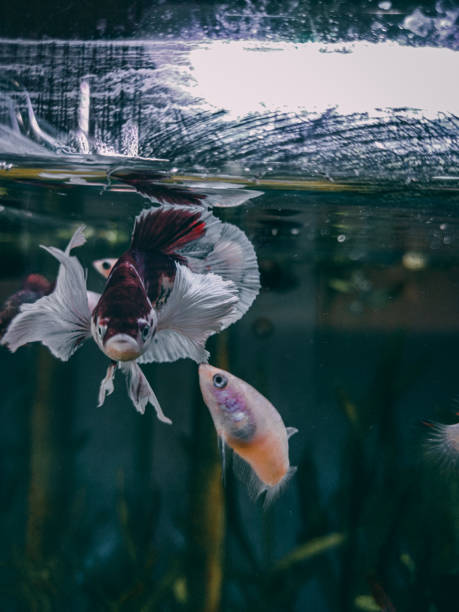Why Your Betta Fish Is Laying at the Bottom of the Tank
Betta fish are tropical fish that are known for their playful and active personalities. Bettas are often kept in small tanks that do not provide them with enough space to swim around. Betta fish are popular as pets because they are easy to care for and are very active.
Some bettas may start to lay at the bottom of the tank if they are not getting the ideal aquarium conditions for them. Bettas will usually lay on the bottom of the tank if they feel ill or are feeling stressed. If you see your betta fish laying at the bottom of the tank, it is best to provide them with more attention and care.
Table of Contents
Is It Normal for Betta Fish to Lay on the Bottom of the Tank?
Betta fish are often seen laying on the bottom of the tank. Betta fish can occasionally lay at the bottom of the tank if they are not feeling well or are stressed. Most of the time, this activity is not normal and may require medical attention.

Causes Why Betta Fish Lay at the Bottom of the Tank
Old Age
Some bettas may lay at the bottom of the tank as they get older, as they may no longer feel safe swimming in the upper levels of the tank. Additionally, as bettas get older, their immune systems may not be as strong and they may be more susceptible to getting sick. If your betta is laying at the bottom of the tank, it may be a good idea to bring it up to the top for a while and see if that helps its health.
Ammonia Poisoning
Betta fish are commonly found laying at the bottom of their tanks, seemingly in distress. This behavior is often referred to as “bottom-dwelling” and is often seen in fish that have been exposed to high levels of ammonia. Ammonia is a by-product of fish metabolism and can be toxic to both fish and humans if it accumulates at high levels. When ammonia levels are high, the fish’s gills can no longer function properly and they resort to laying on the bottom of the tank to avoid absorbing the ammonia.
Nitrate Poisoning
Nitrate poisoning can be caused by several factors, including poor water quality, overfeeding, and inadequate filtration. Nitrate levels in the water can rise quickly if these problems are not corrected. Betta fish that lay on the bottom of the tank is likely displaying signs of distress due to high nitrate levels and should be treated as such.
Too Much Current
Betta fish are often seen laying on the bottom of their tanks due to an excessive current. When the current is too strong, it can sweep the fish away from their home and into an area with less current, where they may lay down to conserve energy. If the current is not too strong, the fish may simply be resting or swimming peacefully.
Extremely High Temperature
High water temperatures can also cause Bettas to lay down at the bottom of their tanks. When the water is too hot, it causes the betta to change its behavior to keep cool. Laying fish rest and conserving energy, so a temperature rise can lead them to do this more frequently. If the water temperature is not too high, lowering it slightly may help alleviate the problem.
Extremely Low Temperature
Some people believe that the reason betta fish lay on the bottom of their tanks is that the water is too cold. Bettas are tropical fish and like warm water. When the water gets too cold, the betta will start to lay on the bottom of their tank to get warm. When the water in the tank is too cold, the Bettas will often lay on the bottom of the tank to keep warm.
Swim Bladder Disease
Swim bladder disease is the most common cause of betta fish laying at the bottom of the tank. This disease causes the fish to lose its ability to swim, and eventually die. It is easiest to diagnose when the fish is first noticed laying at the bottom of the tank, but it can also be caught early by regular water changes and monitoring. Treatment involves antibiotics and surgery if necessary.
Diseases
There are many different reasons why betta fish may lay at the bottom of their tank. Some common reasons include sickness or disease. If you notice your betta fish laying at the bottom of its tank often, it might be a good idea to take it to the vet to check for any health concerns. Betta fish are often found laying on the bottom of their tanks due to sickness or disease. This is usually a sign that the fish needs help and should be taken to a veterinarian as soon as possible.
Relaxation
Betta fish are typically found at the bottom of the tank, but this isn’t always a sign that they are just taking it easy. In some cases, betta fish may lay at the bottom of the tank to avoid being eaten by larger fish or other predators. Additionally, betta fish may lay at the bottom of the tank during times of stress or when they are feeling sick. If you see your betta fish laying at the bottom of the tank, it is important to take action and see a veterinarian to rule out any medical issues.
Sleeping
When a betta fish lays on the bottom of its tank, it might be because it’s sleepy. Bettas are tropical fish that naturally live in warm water, so when they’re kept in a cooler environment, like a tank, they might become sleepy and lay down to take a break.
Insufficient Space
Betta fish are generally active fish and will swim around the tank. When the tank is not large enough, it may lay at the bottom of the tank to conserve energy. Betta fish need at least 10 gallons of water per fish to feel comfortable. If the tank is not large enough, the fish will swim around looking for a place to lay down, and will eventually settle on the bottom.
Unsuitable pH Level
Betta fish require a specific pH level to live and thrive. If the tank’s pH levels are not correct, betta fish might lay at the bottom of their tanks in an attempt to adjust the water chemistry. Laying down can also be a sign that there is something wrong with your filter or water setup, so it is important to have your tank checked by a qualified professional if you notice this behavior from your betta fish.
No Filtration
Some betta fish may lay at the bottom of their tanks due to a lack of proper filtration. If your tank does not have a filter, the water will become stagnant and full of debris, which will cause your betta fish to lay on the bottom. By having a good filter system in place, you can help keep your betta fish healthy and happy in their tank.
Feeding Habits
Betta fish are often seen laying at the bottom of their tanks due to improper eating habits. Bettas are omnivorous and will eat anything that moves, so if their diet consists mostly of algae and other small organisms, they may end up laying on the bottom of their tank to digest their food. If your betta is eating a balanced diet that includes meat, they will likely not lay on the bottom of their tank.
Unfavorable Habitat Features
Betta fish are a popular pet fish, but many people keep them in small tanks that do not provide them with the necessary habitat features to thrive. If the tank does not have a tight-fitting cover that filters out the debris and provides hiding places for the fish, the betta fish will often lay on the bottom of the tank. This is because they are looking for areas where they can hide from predators and find food.
Aggressive Tankmates
If your tank is full of aggressive fish, your betta fish may lay at the bottom to avoid getting injured. Many betta fish owners mistake this behavior for laziness or unwillingness but in reality, it is just a defense mechanism that the fish uses to avoid getting hurt. If you cannot keep your tank filled with friendly and non-aggressive fish, it may be best to find a new home for your pet betta. If your tank is full of the wrong kind of fish, your betta may be trying to find a place to hide.
Death
Betta fish are known for their playful and active personality, but some betta fish may lay at the bottom of their tank due to death. The betta fish may lay at the bottom of the tank when they are stressed or when they are sick. If the betta fish is laying at the bottom of the tank, it may be time to take them to the vet.
Pregnancy
Some female betta fish may lay eggs at the bottom of their tank. This is a sign that the fish is stressed and may need to be taken to the vet. If you notice your female betta laying eggs at the bottom of her tank, it is best to take her to see a veterinarian as soon as possible.
Boredom
There could be many reasons why a betta fish might choose to lay at the bottom of the tank. One possibility is that the fish is lacking in entertainment, and is looking for something to keep it occupied. Other possibilities include a lack of hiding spots or a tank that is too small for the fish. If you notice that your betta is laying at the bottom of the tank more often than not, it might be a good idea to get some additional toys ornaments to keep it amused.

What Can You Do to Help Your Betta Fish Feel More Comfortable?
There are a few things that you can do to help your Betta fish feel more comfortable in their tank. One of the most important things that you can do is to provide them with plenty of hiding places. Make sure to include areas along the bottom of the tank, as well as underneath rocks and plants. Another thing that you can do is to provide them with food that they enjoy eating. This can be things like flakes, pellets, or live foods. Finally, make sure to keep the water clean and clear. This will help your Betta fish feel more comfortable and safe in their tank.
There are a few more things you can do to help your Betta feel more comfortable in its home:
- Provide a place for your Betta to lay down on the bottom of the tank. This can be a small piece of plastic or gravel that has been placed in the tank specifically for this purpose.
- Change the water regularly. Bettas need clean water to stay healthy, and dirty water will make them feel uncomfortable.
- Keep the tank clean. Bettas love to swim around in clean water, so make sure to keep the tank clean. You can do this by keeping it free of debris, and adding new decorations when they are no longer appealing or usable.
- Provide your pet with food that is necessary for its survival – such as pellets or flakes. These foods come in a variety of flavors (such as freeze-dried bloodworms) which means that Betta fish will have something to nibble on at all times.